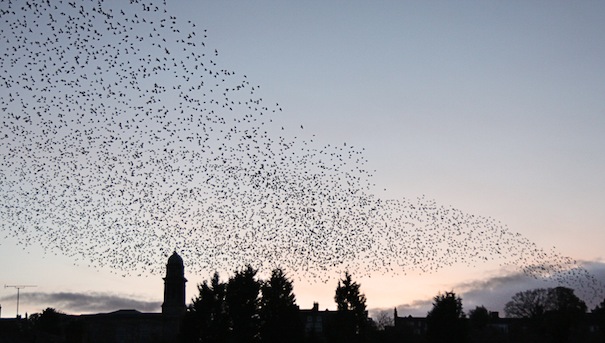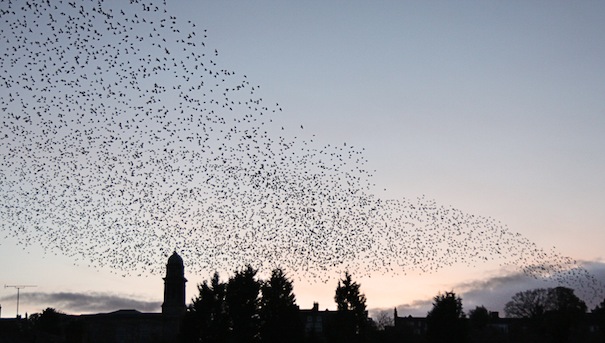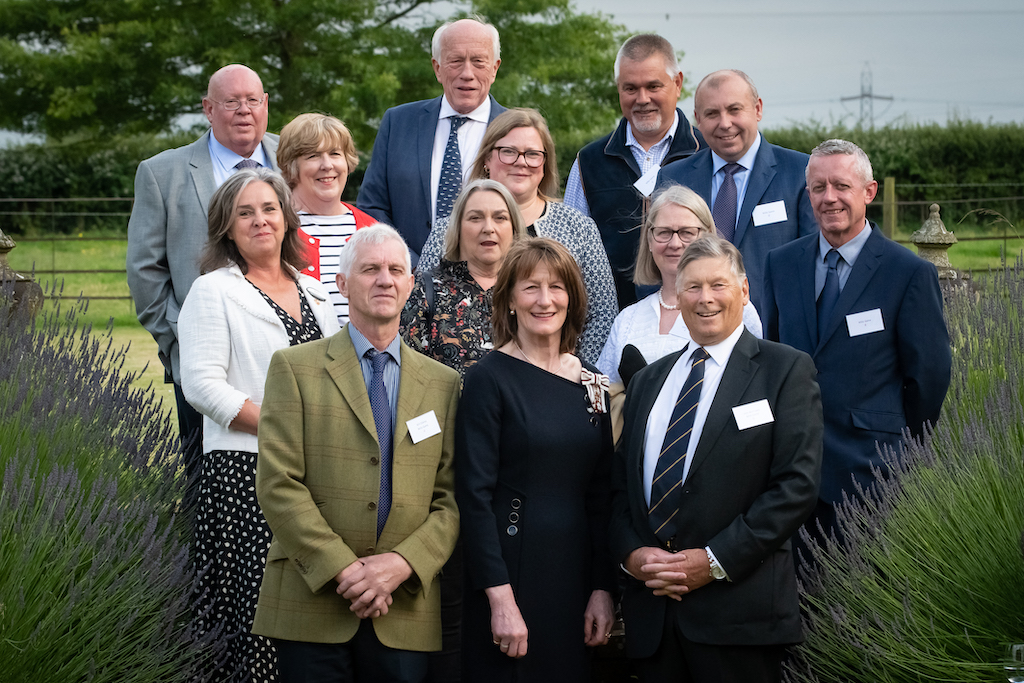Edward Andrews enjoys one of nature’s most captivating sights – a swirling, dancing flock of starlings – and reveals more about these unique birds.
It is a Saturday afternoon and I’m standing on Castle Walk in Bridgnorth. Looking out across low town, I can see traffic streaming across the bridge, signalling the end of a busy day on the market. The temperature is cool but the sky is azure blue and sunshine bathes the town. The winter seed heads of travellers joy cling to the shrubs next to the fence, while the buds are starting to burst, heralding the arrival of spring. A pair of blue tits plays idly amongst the branches. The only suggestion that something spectacular is about to happen is the small gathering of people looking expectantly to the sky.
Almost precisely on cue, a flock of around 30 birds starts to swoop and circle over the valley, each bird seeming to change direction simultaneously. After a few minutes, more birds approach, seamlessly merging into the main flock to create an even more impressive flight display. Over the next hour, more and more starlings join the growing ‘murmuration’. I marvel at the sight of thousands of creatures coalescing into one huge shape-shifting whole. It changes from a tight ball to a rippling sheet to a long ribbon that snakes through the sky. With every change of direction, there comes a change in shape.
A dramatic climax
The birds utilise the entire valley for their incredible display and even disappear momentarily behind the high rock ridge before reappearing. The light is dropping now and a milky half-moon has appeared in the sky, adding to the magical feel of the evening. The birds swoop low down over the river and I struggle to follow their course. Suddenly they are overhead one last time. There are gasps from the crowd as we witness the final act of a wonderful play, the dramatic climax of a ballet. One minute the sky is full of starlings… the next, they are gone.
A large starling murmuration is one of the most spectacular British wildlife spectacles. It is very much a winter phenomenon as our native starlings are joined by winter visitors from Scandinavia. Predators such as peregrine and sparrowhawk are a constant threat so their flocking behaviour affords the starlings safety in numbers. Research has shown that each bird flies as close as possible to its neighbours and detects subtle changes in direction, meaning that the flock seems to shift in unison.
Birds of a feather…
Counting a moving flock of starlings is not an easy task. One technique is to try and count 10 birds and then look at the proportional area of the flock that they take up to enable an estimate to be made. By my reckoning, that Bridgnorth murmuration certainly numbered in the thousands. Some of the biggest starling roosts in the UK are recorded in the Somerset Levels, where up to 6 million birds have been counted roosting together in reed beds.
I walk down into Low Town and make my way to a conifer tree on the riverside, just upstream from the bridge. A large number of the starlings are roosting in the tree, chattering noisily. In the darkness I can just make out the movement of the birds as they jostle for position in the roost. Suddenly a flock breaks away and flies towards where most of the birds are roosting. As they fly overhead, I hear the patter of droppings.
Why the month of March saw the arrival of such a large flock of starlings over Bridgnorth is a mystery, but they quickly became the talk of the town. Each evening, people would gather in car parks, on the bridge and at other vantage points, hoping to catch a glimpse of the spectacle. Cameras flashed and videos of the birds even made it onto the internet. Even if you have no interest in wildlife, a large starling murmuration will reach out and touch you, waking up a wild instinct that burns inside all of us. All too soon, the birds were gone. They left for their spring breeding grounds either here or abroad. I’m sure that, for anyone who made the effort to witness the murmuration, the memory of that beautiful swirling mass of birds over the Severn Valley will live on in the memory for a very long time.
Do one thing for wildlife this month…
Starlings were once a common bird. From a distance they look black but, on closer inspection, they have an almost iridescent plumage streaked with purple and green. I think they are one of the most attractive birds that you could wish to see in your garden. Since 1979, the RSPB have recorded a 79% decline in the starling population in British gardens. It is not clear exactly why they have declined so much. To help your local starling population, try and keep areas of both short and longer grass in your garden and avoid the use of any lawn chemicals that can kill invertebrates in the soil (these are potential food for the starlings).
What’s What! nature expert and Shropshire Council Parks and Countryside Sites Officer Ed Andrews (MSc) looks at the changing seasons in each issue.







